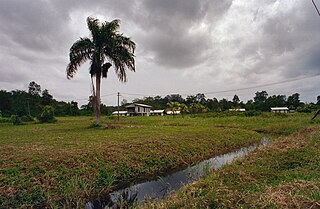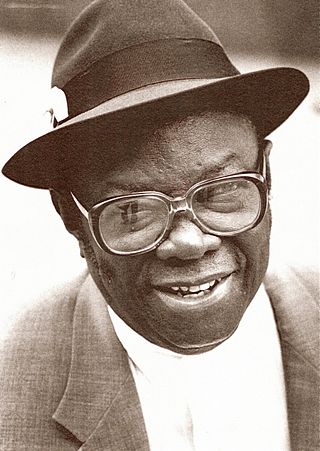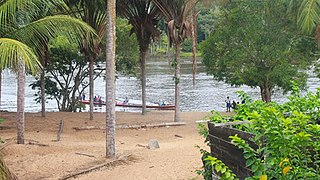
Commewijne is a district of Suriname, located on the right bank of the Suriname River. Commewijne's capital city is Nieuw Amsterdam. Tamanredjo is another major town, while Meerzorg is the most populated.
Indo-Caribbeans or Indian-Caribbeans are people in the Caribbean who are descendants of the Jahaji indentured laborers from India and the wider subcontinent, who were brought by the British, Dutch, and French during the colonial era from the mid-19th century to the early 20th century. A minority of them are descendants from people who immigrated as entrepreneurs, businesspeople, merchants, engineers, doctors, religious leaders and other professional occupations beginning in the mid-20th century.

Nieuw Amsterdam is the capital of the Commewijne District in Suriname. It is a small coastal town situated at the confluence of the Suriname River and Commewijne River, just across from Paramaribo, the country's capital. Its population at the 2012 census was 5,650, with around 1,200 people living in the main town, most of whom are of Javanese and East Indian origin. It is the location of the historical Fort Nieuw-Amsterdam, today an open-air museum. The town of Mariënburg with former sugarcane factory is located 3 km from Nieuw Amsterdam and part of the resort.
Indo-Surinamese, Indian-Surinamese or Hindustani Surinamese are nationals of Suriname with ancestry from India and the wider subcontinent. Their ancestors were Indian indentured workers brought by the Dutch and the British to the (then) Dutch colony of Suriname during the mid-19th to the early 20th century. Per the 2012 Census of Suriname, 148,443 citizens of Suriname are of Indo-Surinamese origin, constituting 27.4% of the total population, making them the largest ethnic group in Suriname on an individual level.

Eugène Constantijn Donders Drenthe was a prominent Surinamese poet and playwright.

Jules Sedney was a Surinamese politician, and Prime Minister of Suriname from 20 November 1969 to 24 December 1973. In 1980, he became governor of the Central Bank of Suriname, but had to flee the country in 1983 after a dispute with Dési Bouterse. Sedney returned to Suriname in 1989.
Indians in the Netherlands are residents of Indian origin in the Netherlands. The majority of the people of Indian descent in the Netherlands are of Indo-Surinamese origin. More recently the flow of emigrants from India has increased, especially information technology professionals, as well as from Guyana and Trinidad and Tobago, mostly those married to Indo-Surinamese.

Ronnie Brunswijk is a Surinamese politician, businessman, former rebel leader, footballer and convicted drug trafficker, who is serving as the current Vice President of Suriname.

Chandrikapersad "Chan" Santokhi is a Surinamese politician and former police officer who is the 9th president of Suriname, since 2020. After winning the 2020 elections, Santokhi was the sole nominee for president of Suriname. On 13 July, Santokhi was elected president by acclamation in an uncontested election. He was inaugurated on 16 July.

Emile Linus Alfred Wijntuin was a Surinamese politician who served as Chairman of the National Assembly of Suriname from 1975 until the aftermath of the 1980 Surinamese coup d'état. Wijntuin was a member of the Progressive Surinamese People's Party (PSV).

Pikin Slee is a village on the Upper Suriname River in the resort Boven Suriname of the Sipaliwini District. It is home to about 3,000 people, and the second largest village of the Saramaka Maroons, after Aurora.

Johannes François Adriaan Cateau van Rosevelt was a Dutch navy officer and civil servant in Suriname where he was, among other things, agent-general for immigration and a member of the Colonial Estates of Suriname. He is known for his map of Suriname.

Kalebaskreek is an indigenous village of Kalina Amerindians in the resort of Calcutta in the Saramacca District in Suriname.
Hollandse Kamp is an indigenous village of Lokono Amerindians in the resort of Zuid in the Para District in Suriname. The village is located south of the Johan Adolf Pengel International Airport.

Asongo Alalaparu, also Ashongo Alalaparoe, was a Granman of the indigenous Tiriyó people in Suriname. He led the Tiriyó from 1997 to 2021 from his residence in Kwamalasamutu. During his rule, the Tiriyó established new small villages in the interior of Suriname.

Diplomatic relations between Suriname and Venezuela were established in November 1975, shortly after the independence of Suriname. Suriname has an embassy in Caracas since 1976. Venezuela has an embassy in Paramaribo. As of 30 June 1978, there is no travel visa requirement between the two countries.

Frans Pavel Vaclav Killinger was a military officer and police inspector in Suriname who planned to commit the first coup d'état in Suriname on the night of 25 to 26 May 1910. The coup was betrayed, and he was sentenced to death which was later commuted to five years imprisonment. In December 1913, he was released from jail. Later, he enlisted in the cavalry of the Ottoman Army as Muhammed Tewfig Killinger.
Prawas Din or Surinamese Immigration Day is the day that commemorates the arrival of the first Indian contract workers in Suriname on June 5, 1873, on the Lalla Rookh. The commemoration takes place on June 5.













